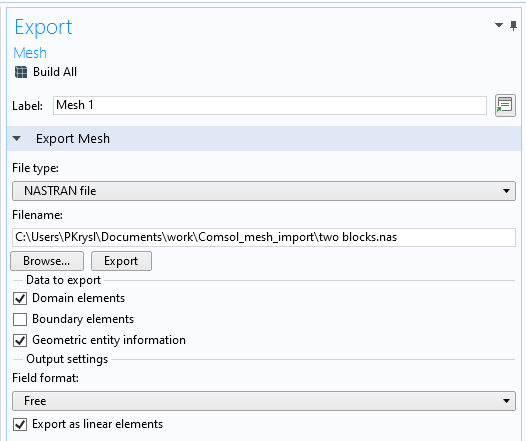Summary: Run the solution of the free vibration problem for multimaterial domains created in Comsol.
Clone this repository as
git clone https://github.com/PetrKryslUCSD/RunMultimaterialVibEP.jl.git
This will create a folder by the name RunMultimaterialVibEP.jl in the current directory. This folder may be renamed arbitrarily. In the present example we rename this folder to TwoBlocks.
Now change your working directory to the folder TwoBlocks.
Use Comsol to create a mesh. Make sure to create materials for each material domain and assign the material to the domain. The material parameters don't matter: the materials are not exported themselves. Just the mesh. Remember the numbers of the materials (1, 2, ...): the parameter file will need to refer to these numbers.
A note about units: Comsol allows us to control the physical units. However, during export that information is lost. It is not clear how the data in the exported file is associated with units. I've only tried SI units with lengths in meters. The export was in meters.
Export the mesh as a NASTRAN file. Use the settings shown in this image:

Create the parameter file for the simulation. Call this file whatever you wish. There is an example of such a parameter file, called "twoblocks.json". The parameter file is a JSON file with this structure:
{
"meshfile": "twoblocks.nas",
"neigvs": 20,
"frequencyshift": 10.0,
"materials": {
"2": {
"name": "aluminum",
"E": 7.0e10,
"nu": 0.34,
"rho": 2700.0
},
"1": {
"name": "steel",
"E": 2.05e11,
"nu": 0.3,
"rho": 7850.0
}
}
}
Change the parameters appropriately. Materials can be added. Note that the numbers of the materials in the Comsol model are recorded here as strings.
A note about units: The units for the materials needs to be consistent with the units for the lengths in the mesh file.
Edit the file run.jl. There is an example of this file in the current folder with the following contents:
using Pkg;
Pkg.activate("."); Pkg.instantiate()
using FinEtoolsMultimaterialVibEP: solve_ep
# The name of the parameter file is up to you
parameterfile = "twoblocks.json"
solve_ep(parameterfile)
exit()
Note that the name of the parameter JSON file is the one created in the previous section.
Make sure your working directory is the folder TwoBlocks as set up by the cloning of this repository.
Run the script run.jl in Julia as follows
julia run.jl
It is possible that the first time this script is run it will take longer: an update of the Julia registry needs to be performed so that all the packages needed for the simulation are installed. When the script finishes, it prints the computed natural frequencies, and it writes out the output into files.
Assuming as above that the parameter file was called "twoblocks.json", the output is written in the Matlab format into twoblocks.mat. The following quantities are included:
- Eigenvalues.
- Eigenvectors.
- The surface panels. The connectivity
conn(connectivity of the surface panels), and the coordinatesX(coordinates of all the nodes in the mesh). - Areas of the surface panels in the order in which the connectivity is given.
- Acoustic coupling sparse matrix.